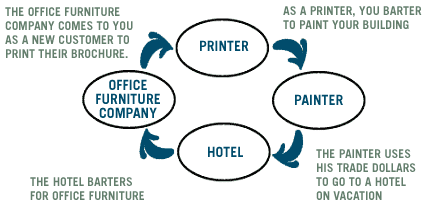Barter Exchanges
Bartering is the trading of one product or service for another. Usually there is no exchange of cash. Barter may take place on an informal one-on-one basis between individuals and businesses, or it can take place on a third party basis through a barter exchange company. A barter exchange is any person or organization with members or clients that contract with each other (or with the barter exchange) to jointly trade or barter property or services. The term does not include arrangements that provide solely for the informal exchange of similar services on a noncommercial basis. Unlike one-on-one bartering, members of exchanges are not obligated to barter or purchase directly from a seller. Instead, when a barter exchange member sells a product or a service to another member, their barter account is credited for the fair market value of the sale. When a barter exchange member buys, the account is debited for the fair market value of the purchase..
The Barter System - Is It for You?
Whether you are starting or growing a small business, using a barter system preserves working capital to apply to your venture. Also called in-kind trade, trade-outs, counter-trades or contra agreements, this process can fund day-to-day operational expenses without cash outlay. By definition, bartering is the exchange of goods and services for other goods or services. Research indicates that nearly one-third of U.S. small businesses use some type of bartering system (Barter News Weekly) Even so, some experts believe companies are not maximizing their own barter possibilities.
Benefits of Bartering
- Generates sales/profits with faster inventory and service-hour turnover
- Creates new customers by bringing together parties who may refer others
- Moves surplus stock
- Eliminates additional advertising and deep discounts
When to Barter
A barter system can involve swapping big-ticket items, but many small-company owners stick with products and services required for routine operations. These include:.
- Office supplies, printer/toner cartridges, food service, renovations/repairs
- Printing, computer products/services, trade show booth space
- Communications, Internet access, cellular phones, electronics
- Staff incentives and community sponsorships
Financial services, legal advice, health care, advertising or promotionHow It Works The barter process, unlike a cash transaction, requires no exchange of money between trading parties. However, barter dollars are identical to real dollars at income tax-time, so owners must report the fair market value of goods received on their tax returns. In fact, entrepreneurs should treat barter revenue like any of their other business activities, making sure to:
- Keep good records.
- Specify the retail value of products being exchanged.
- Work with a good barter exchange
- Consult a tax professional, if necessary











